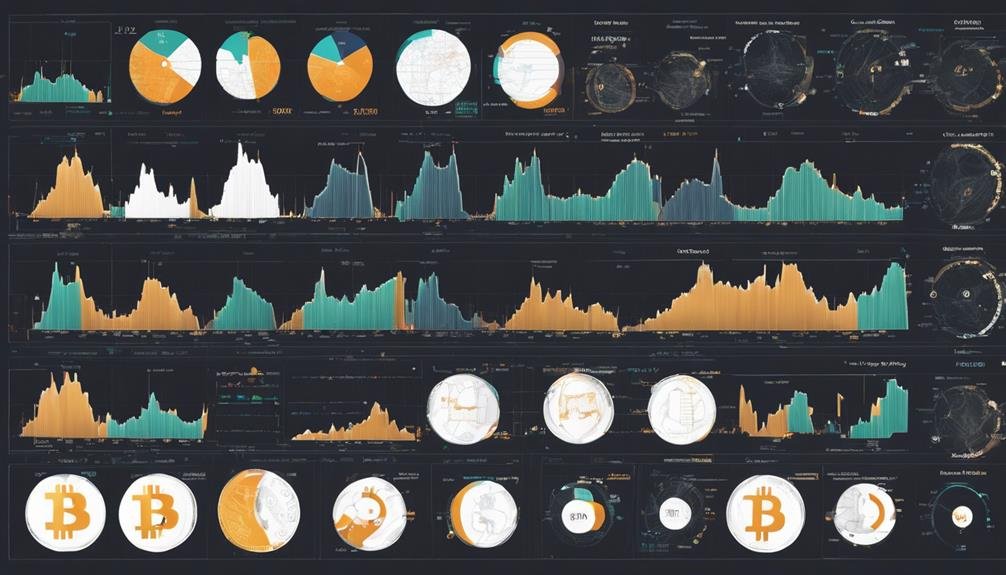Detecting Bitcoin trading spoofing is crucial to preserving market integrity. Spoofing involves deceptive tactics like order manipulation to influence prices and mislead traders. Analyzing trading patterns, monitoring order book depth, and evaluating trading volume are critical steps in spotting fraudulent activities. By understanding these techniques, one can effectively prevent market manipulation and maintain a secure trading environment.
The insights gained from these analyses provide valuable tools to combat spoofing in the Bitcoin market. By recognizing the signs of manipulation and staying vigilant, one can safeguard against fraudulent practices and guarantee a fair and transparent marketplace.
Table of Contents
Brief Overview of Detecting Spoofing Activity In Bitcoin Trading
- Analyzing trading patterns reveals irregularities indicative of spoofing.
- Monitoring trading volume for abnormal patterns detects potential spoofing activities.
- Identifying abnormal price fluctuations signals potential spoofing attempts.
- Tracking order book depth aids in detecting manipulation in Bitcoin trading.
- Implementing strict KYC procedures helps prevent spoofing and maintain market integrity.
Understanding Spoofing Techniques
Spoofing techniques in Bitcoin trading involve the strategic submission and cancellation of multiple orders to fabricate false market depth and deceive market participants. This form of manipulation aims to create the illusion of substantial buy or sell interest in a particular cryptocurrency, influencing other traders to make decisions based on false information. By engaging in abnormal trading activities such as layering and quote stuffing, spoofers can artificially impact prices and order book depth, leading to market disruptions and potential losses for unsuspecting investors. These manipulative activities erode trust in the market and can result in increased volatility<span data-preserver-spaces=”true”>.
To detect spoofing, market participants and regulators must closely monitor for sudden shifts in trading patterns and frequent order cancellations that deviate from typical market behavior. Recognizing these red flags is essential in identifying and preventing the harmful effects of spoofing in Bitcoin trading. Regulators like the CFTC and SEC play an important role in enforcing regulations to deter such deceptive practices and maintain market integrity.
Analyzing Trading Patterns

Analyzing trading patterns in Bitcoin involves scrutinizing trading volume and price fluctuation patterns for irregularities. Detecting sudden changes in these aspects can be indicative of potential spoofing activities. By closely monitoring the timing, frequency, and consistency of order placements, one can uncover suspicious trading behaviors that may signal spoofing.
Trading Volume Analysis
Effective detection of Bitcoin trading spoofing requires a meticulous examination of trading volume patterns to identify any anomalies indicative of manipulative activities. Analyzing trading volume is vital in detecting spoofing practices, as abnormal volume patterns can signal potential manipulation in Bitcoin markets. Unusual spikes or drops in trading volume serve as red flags for potential spoofing attempts.
Tracking the correlation between price fluctuations and trading volume helps identify anomalous trading patterns linked to spoofing. By comparing trading volume data with historical patterns and market trends, discrepancies that hint at spoofing practices can be uncovered. Detailed analysis of trading volume data offers valuable insights into the legitimacy of price movements and the presence of spoofing in Bitcoin trading.
Price Fluctuation Patterns
To expose potential spoofing activities in Bitcoin trading, a comprehensive examination of price fluctuation patterns is vital. Analyzing trading patterns is essential in identifying abnormal trading behaviors that may indicate spoofing attempts. Sudden price spikes or drops can be red flags, suggesting manipulation in the market. Monitoring the frequency and size of order cancellations can also provide insights into potential spoofing activities impacting Bitcoin prices.
By understanding the typical trading patterns of Bitcoin and being vigilant for deviations, traders can better detect spoofing behaviors. Leveraging trading data analysis tools is instrumental in recognizing unusual trading patterns associated with potential spoofing activities in Bitcoin markets. Stay vigilant and attentive to price movements to mitigate risks associated with spoofing in cryptocurrency trading.
Monitoring Order Book Depth

Order book depth plays an important role in evaluating market liquidity and understanding potential price impacts. By monitoring order book depth, traders can utilize pattern recognition techniques to detect unusual activities that may indicate spoofing attempts. Analyzing changes in order book depth provides valuable insights into market sentiment shifts. It helps identify manipulation efforts in Bitcoin trading.
Depth Vs. Liquidity
Through the analysis of buy and sell orders at different price levels, traders can gain valuable insights into market liquidity and identify potential support and resistance levels. This practice, known as monitoring order book depth, is crucial for making informed trading decisions. This depth reflects the trading behavior of market participants, indicating areas where large buy or sell orders are concentrated.
Understanding order book depth is vital for predicting potential price swings, as areas with significant buy orders may act as support levels. In contrast, areas with substantial sell orders may act as resistance levels. Traders closely monitoring order book depth can anticipate market movements based on the distribution of buy and sell orders, helping them navigate through volatile trading conditions with more informed decision-making.
Price Impact Analysis
The analysis of price impact, through monitoring order book depth, is essential for understanding market dynamics and detecting potential spoofing activities. Tracking the cumulative volume of buy and sell orders at different price levels and monitoring order book depth enable the identification of sudden changes in order sizes that may indicate spoofing. Price impact analysis assesses how large orders, whether placed or canceled, influence market prices and liquidity.
Detecting spoofing relies on understanding order book dynamics, as abnormal order sizes can distort market perceptions. Real-time monitoring of order book depth provides valuable insights into market manipulation tactics, aiding in the prevention of spoofing in Bitcoin trading. Monitoring order book depth plays a significant role in maintaining the integrity of the trading environment and safeguarding against fraudulent activities.
Pattern Recognition Techniques
Utilizing advanced pattern recognition techniques in monitoring order book depth is essential for detecting potential spoofing activities in Bitcoin trading. By analyzing trading data and observing suspicious activities within the order book, anomalies that may indicate spoofing attempts can be identified. Pattern recognition techniques are crucial in differentiating fraudulent activities from typical market behavior.
Monitoring changes in order book depth allows for the detection of sudden irregularities, such as unexpected spikes or vanishing orders, which could be indicative of spoofing. Understanding the typical patterns of order book depth is important for recognizing deviations that warrant further investigation. Detecting unusual behaviors in order book depth patterns serves as a valuable tool in uncovering and preventing potential spoofing activities in the dynamic landscape of Bitcoin trading.
Evaluating Volume and Liquidity

Analyzing volume and liquidity in Bitcoin trading is essential for detecting potential spoofing activities by identifying irregular trading patterns. By monitoring trading volume, market participants can spot sudden spikes or drops that may indicate manipulation. Additionally, keeping an eye on the order book depth and liquidity levels can help uncover abnormal behaviors, such as the rapid cancellation of large orders, a common tactic used in spoofing.
Unusual trading volume compared to historical averages can serve as a warning sign for potential spoofing activities, prompting further scrutiny of the trading behavior. Liquidity analysis is pivotal in distinguishing genuine trading interests from fake orders aimed at distorting prices. Genuine liquidity tends to exhibit more stable trading patterns, making any anomalies easier to spot. Understanding the intricate relationship between volume, liquidity, and price movements is paramount in the fight against spoofing and market abuse in the Bitcoin trading landscape.
Implementing KYC Procedures

To bolster the scrutiny against potential spoofing activities in Bitcoin trading, strong implementation of Know Your Customer (KYC) procedures is vital. KYC procedures in cryptocurrency trading involve verifying users’ identities and evaluating their risk profiles. By implementing KYC best practices, exchanges can comply with regulatory requirements and prevent money laundering activities. These procedures typically require users to provide identification documents, proof of address, and sometimes the source of funds. Exchanges may also conduct enhanced due diligence for high-risk users or identify suspicious trading activity flagged during KYC checks.
KYC plays an essential role in maintaining the integrity of digital currency markets and reducing the risk of illicit activities. It serves as a proactive safeguard against deceitful activities and promotes openness within the ecosystem of cryptocurrency trading. By adhering to stringent KYC procedures, exchanges can create a more secure environment for traders and investors, ultimately contributing to the legitimacy and stability of the Bitcoin market.
Collaborating for Effective Detection

Collaboration among exchanges, regulators, and industry stakeholders is essential for bolstering the effectiveness of detecting Bitcoin trading spoofing activities. Through collaboration, these pivotal stakeholders can exchange significant insights and data, thereby bolstering their capacity to identify dubious trading activities that could signify deception.
Information sharing is critical in the fast-paced world of financial markets, where a coordinated response can help prevent price manipulation and guarantee the integrity of trading activities. Implementing advanced monitoring systems and data analysis techniques can further improve detection capabilities, allowing for the swift identification of potential spoofing attempts.
Furthermore, rigorous Know Your Customer (KYC) protocols are of utmost importance in authenticating the identities of merchants, thereby mitigating the potential for spoofing incidents. Regular audits and compliance checks add another layer of security, contributing to a robust framework for detecting and deterring Bitcoin trading spoofing. By collaborating and leveraging each other’s strengths, exchanges, regulators, and industry stakeholders can effectively safeguard the integrity of the market against fraudulent trading practices.
Frequently Asked Questions
How Do You Detect Spoofing Trading?
Detecting spoofing trading involves monitoring trading algorithms, order book activity, and price movements. Look for irregularities like disproportional order sizes and sudden market reversals. Utilize real-time market data and analysis tools for effective detection.
How Do You Detect Market Manipulation?
Detecting market manipulation involves analyzing abnormal volume, order book depth, and price movements. Utilizing advanced algorithms for pattern recognition can aid in spotting anomalies. Collaboration with exchanges and regulators, along with strict KYC procedures, enhances detection efforts against spoofing activities.
Is Spoofing Trading Illegal?
Spoofing trading is illegal and constitutes market manipulation. Legal implications include fines and penalties. Regulatory bodies such as the CFTC, SEC, FCA, FSA, and SFC enforce laws against spoofing. Violators face potential legal consequences.
What Is the Strategy of Spoofing?
The strategy of spoofing involves placing deceptive orders to manipulate market perception. By creating false demand or supply, spoofers aim to influence prices. This unethical practice can artificially impact market dynamics, leading to price manipulation and disrupting trading activities.
Conclusion
To summarize, detecting bitcoin trading spoofing requires a thorough understanding of spoofing techniques, analysis of trading patterns, monitoring order book depth, evaluating volume and liquidity, and implementing KYC procedures. Collaboration among stakeholders is essential for effective detection. By applying these strategies and working together, the cryptocurrency community can combat spoofing and maintain a more secure trading environment.




